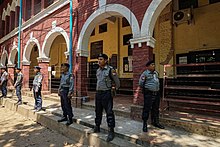Inn Din massacre
[8] According to Amnesty International, the Rohingya have suffered from human rights violations under past military dictatorships since 1978, and many have fled to neighbouring Bangladesh as a result.
Several hundred Rohingya villagers fled from the west hamlet of Inn Din to the mountains in the east, many with the intent to escape to refugee camps in Bangladesh.
Soe Chay, a retired soldier and local who supposedly helped dig the mass grave, told Reuters that each victim was shot two to three times.
According to Chay, some of the victims managed to survive and made noises whilst being buried alive, prompting a group of local paramilitaries to hack them to death with machetes.
[1] Through a Facebook post by Senior General Min Aung Hlaing, the Tatmadaw (armed forces) announced they would investigate reports of a mass grave in the village of Inn Din.
[7] A statement on behalf of the military was posted by Min Aung Hlaing to his Facebook page on 10 April 2018, announcing that seven soldiers had been convicted of murder for their participation in the executions and sentenced to ten years in prison with hard labour in a "remote area".
[19] On 12 December 2017, members of Myanmar's police force arrested Reuters journalists Wa Lone and Kyaw Soe Oo at a restaurant in Yangon after inviting them to dinner.
[20] The pair was charged with possessing classified documents in violation of the colonial-era Official Secrets Act, which carries a possible sentence of 14 years in prison.
[36] Wa Lone and Kyaw Soe Oo have received international awards for their reporting of the Inn Din massacre, and were included in Time magazine's Person of the Year 2018, which recognised persecuted journalists as "guardians" in a "war on truth".
